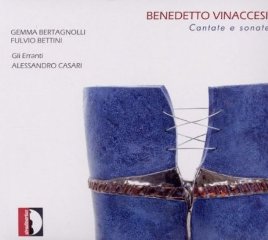Benedetto Vinaccesi - Cantate e Sonate (2011)
Benedetto Vinaccesi - Cantate e Sonate (2011)

1. Or Fia Mai Ver, O Lontananza Infida 2. Sonata IV 3. Belve, Se Mai Provaste 4. Sonata III 5. In Lontananza Della Sua Donna 6. Amor Pericoloso Gemma Bertagnolli - Soprano Fulvio Bettini - Baritone Alessandro Casari - Clavicembalo, Conductor Gli Erranti (Ensemble)
The most unusual, and in some respects most interesting, works by Vinaccesi to have survived are his six Suonate da camera tre, Op. 1. They are among the very first published chamber sonatas to comprise not one movement but an integrated cycle of several movements. Their originality apart, these sonatas deserve to be championed for a quality perhaps unexpected from a composer so young: their high level of motivic coherence. All the cantatas recorded here make an excellent introduction to Vinaccesi´s music. They display some of the most attractive features of the composer´s musical style, which include the sudden burst of florid writing that seem to arrive from nowhere, the finely wrought cavatas (a cavata is a setting of a section of recitative verse in a more elaborate, arialike manner) and the attractive, always thematically relevant, instrumental ritornellos. ---amazon.com
Benedetto Vinaccesi (1666-1719) was a gifted and, in his day, much-admired Italian composer from the period of Corelli. His significant corpus of works includes operas, oratorios, sonatas, cantatas, and church music of many kinds, and Talbot's description brings to light their striking originality. More importantly, perhaps, since Vinaccesi's music harks back to an earlier generation of Italian composers (Legrenzi, Stradella, Colonna) yet also anticipates the later developments of Albinoni and Vivaldi, it constitutes an unusual amalgam of elements identified today as "middle" and "late" baroque, and Talbot's survey is able to place in focus many neglected aspects of stylistic evolution in the years around 1700. His chronicle of the Vinaccesi family and description of the "citizen" class to which it belonged is invaluable for the light it sheds on the place of the composer in seventeenth-century Italy. He also provides a wealth of other information on the society, institutions, and local history of Italy (especially Brescia and Venice) in the seventeenth and eighteenth centuries. The result is a rounded portrait of an important musician, which also serves to illuminate many aspects of the Italian baroque. --- torontopubliclibrary.ca
download (mp3 @192 kbs):
yandex 4shared mega mediafire zalivalka cloudmailru uplea








